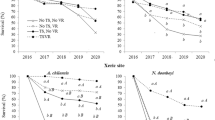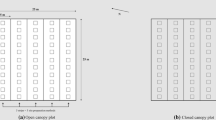Abstract
Shelterwood method is indispensable in many forests where common clearcuts are excluded due to nature conservation, recreational use, or need for special management. We evaluated the impacts of light conditions, site fertility, cutting intensity, and soil scarification on the natural conifer regeneration density and height growth in Scots pine (Pinus sylvestris L.) stands managed by shelterwood cutting. The aim of the study was to reveal functionally important site parameters in the shelterwood system that affects conifer regeneration most strongly in hemiboreal forest. In general, the number of shelter trees decreased conifer regeneration height increment and success index (density × mean height/time since initial cutting). After the first cut, the optimal amount of first storey shelter trees was around 200 trees ha−1, or half of the basal area of the normal stand. Soil scarification increased and higher proportion of deciduous regeneration decreased density-related parameters (density and success index) of conifer regeneration. The positive effect of scarification was pronounced on poor soils, where density increase was fivefold. The conifer regeneration characteristics were not affected by soil properties, except soil phosphorus, which was positively correlated with seedlings’ height growth. Site fertility increased height increment and success index after the second cut, when regenerated trees are larger. Although shelterwood cutting is commonly applied in less productive forest types in boreal and hemiboreal pine forests, this regeneration method can be just as successful also in fertile sites.



Similar content being viewed by others
References
Axelsson EP, Lundmark T, Högberg P, Nordin A (2014) Belowground competition directs spatial patterns of seedling growth in boreal pine forests in Fennoscandia. Forests 5(9):2106–2121
Beese JW, Bryant AA (1999) Effect of alternative silvicultural systems on vegetation and bird communities in coastal montane forest of British Columbia, Canada. For Ecol Manag 115:231–242
Béland M, Agestam E, Ekö PM, Gemmel P, Nilsson U (2000) Scarification and seedfall affects natural regeneration of scots pine under two shelterwood densities and a clear-cut in southern Sweden. Scand J For Res 15:247–255
Bettinger P, Boston K, Siry JP, Grebner DL (2017) Estimation and projection of stand and forest conditions. In: Bettinger P, Boston K, Siry JP, Grebner DL (eds) Forest management and planning, 2nd edn. Academic Press, London, pp 87–111
Brække FH, Salih N (2002) Reliability of foliar analyses of Norway spruce stands in a Nordic gradient. Silva Fenn 36:489–504
de Chantal M, Leinonen K, Kuuluvainen T, Cescatti A (2003) Early response of Pinus sylvestris and Picea abies seedlings to an experimental canopy gap in a boreal spruce forest. For Ecol Manag 176(1–3):321–336
Elfving B, Jakobsson R (2006) Effects of retained trees on tree growth and field vegetation in Pinus sylvestris stands in Sweden. Scand J For Res 21:29–36
Erefur C, Bergsten U, de Chantal M (2008) Establishment of direct seeded seedlings of Norway spruce and Scots pine: effects of stand conditions, orientation and distance with respect to shelter tree, and fertilisation. For Ecol Manag 255:1186–1195
Erefur C, Bergsten U, Lundmark T, de Chantal M (2011) Establishment of planted Norway spruce and Scots pine seedlings. Effects of light environment, fertilisation, and orientation and distance with respect to shelter trees. New For 41:263–276
Fady B, Cottrell J, Ackzell L, Alía R, Muys B, Prada A, González-Martínez SC (2016) Forests and global change: what can genetics contribute to the major forest management and policy challenges of the twenty-first century? Reg Environ Change 16:927–939
Forest Act. RT I 2006, 30, 232. https://www.riigiteataja.ee/en/eli/ee/525032015010/consolide/current. Accessed 5 Feb 2019
Granhus A, Metslaid M, Von Lüpke N (2016) Effects of nutrient supply on understory Picea abies seedling growth in partially cut stands in south-east Norway. Forestry 89:182–190
Grigoriadis N, Spyroglou S, Grigoriadis S, Klapanis P (2014) Effect of soil scarification on natural regeneration of mature Scots pine Pinus sylvestris) stands in Greece. Global Nest J 16(4):732–742
Hannerz M, Hånell B (1997) Effects on the flora in Norway spruce forest following clearcutting and shelterwood cutting. For Ecol Manag 90:29–49
Hanssen KH, Granhus A, Brække FH, Haveraaen O (2003) Performance of sown and naturally regenerated Picea abies seedlings under different scarification and harvesting regimens. Scand J For Res 18:351–361
Hille M, Den Ouden J (2004) Improved recruitment and early growth of Scots pine (Pinus sylvestris L.) seedlings after fire and soil scarification. Eur J For Res 123:213–218
Ingestad T (1987) New concepts on soil fertility and plant nutrition as illustrated by research on forest trees and stands. Geoderma 40(3–4):237–252
Jakobsson R (2005) Growth of retained Scots pines and their influence on the new stand. Ph.D. thesis. Swedish University of Agricultural Sciences (SLU), Umeå
Järvis J (2013) Forest measurement with relascope. Practical description for fieldwork with examples for Estonia. Formaks, Tartu https://dspace.emu.ee/xmlui/bitstream/handle/10492/4607/Relascope_en_2013.pdf?sequence=1&isAllowed=y. Accessed 04 July 2019
Jiménez Esquilín AE, Stromberger ME, Shepperd WD (2008) Soil scarification and wildfire interactions and effects on microbial communities and carbon. Soil Sci Soc Am J 72:111–118
Kara F, Topaçoğlu O (2018) Influence of stand density and canopy structure on the germination and growth of Scots pine (Pinus sylvestris L.) seedlings. Environ Monit Assess 190:749
Karlsson M, Nilsson U (2005) The effects of scarification and shelterwood treatments on naturally regenerated seedlings in southern Sweden. For Ecol Manag 205:183–197
Karlsson C, Örlander G (2000) Soil scarification shortly before a rich seed fall improves seedling establishment in seed tree stands of Pinus sylvestris. Scand J For Res 15:256–266
Kuuluvainen T, Pukkala T (1989) Effect of Scots pine seed trees on the density of ground vegetation and tree seedlings. Silva Fenn 23:159–167
Laas E, Väät T (2004) Shelterwood system in Scots pine stands and pine regeneration under shelterwood (in Estonian, with summary in English). For Stud 41:86–100
Lieffers VJ, Messier C, Burton PJ, Ruel J-C, Grover BE (2003) Nature-based silviculture for sustaining a variety of boreal forest values. In: Burton PJ, Messier C, Smith DW, Adamowicz WL (eds) Towards sustainable management of the boreal forest. NRC Research Press, Ottawa, pp 481–530
Lõhmus E (1984) Eesti metsakasvukohatüübid. [Estonian forest site types.] Eesti NSV Agrotööstuskoondise Info- ja juurutusvalitsus. Tallinn, Estonia (in Estonian with English summary)
Matthews JD (1989) Silvicultural systems. Clarendon Press, Oxford, p 296
Messina MG, Jenkins J (2000) Loblolly pine stand early development under reserve-tree silvicultural systems in East Texas. South J Appl For 24:11–16
Moilanen M, Hytönen J, Hökkä H, Ahtikoski A (2015) Fertilization increased growth of Scots pine and financial performance of forest management in a drained peatland in Finland. Silva Fenn 49(3), 1301
Örlander G, Egnell E, Albrektson A (1996) Long-term effects of site preparation on growth in Scots pine. For Ecol Manag 86:27–37
Padari A (2004) Forest assessment software ‘‘RaieWin’’. M.Sc. thesis (in Estonian, abstract in English)
Palviainen M, Finér L, Kurka AM, Mannerkoski H, Piirainen S, Starr M (2004a) Decomposition and nutrient release from logging residues after clear-cutting of mixed boreal forest. Plant Soil 263:53–67
Palviainen M, Finér L, Kurka AM, Mannerkoski H, Piirainen S, Starr M (2004b) Release of potassium, calcium, iron and aluminium from Norway spruce, Scots pine and silver birch logging residues. Plant Soil 259:123–136
Pitt DG, Hoepting MK, Parker WC, Morneault AE, Lanteigne L, Stinson A, Farrell JCG (2016) Optimum vegetation conditions for successful establishment of planted eastern white pine (Pinus strobus L.). Forests 7(8):1–2
Prévosto B, Ripert C (2008) Regeneration of Pinus halepensis stands after partial cutting in southern France: impacts of different ground vegetation, soil and logging slash treatments. For Ecol Manag 256:2058–2064
Pribyl DW (2010) A critical review of the conventional SOC to SOM conversion factor. Geoderma 156:75–83
Puri BR, Murari K (1963) Studies in surface area measurements of soils: 1. Comparison of different methods. Soil Sci 96:331–336
R Core Team (2012) R: a language and environment for statistical computing. R Foundation for Statistical Computing, Vienna
Reyes J, Thiers O, Gerding V (2014) Characterization of soil properties of Nothofagus spp. forest with and without scarification in the Andean region of southern Chile. J Soil Sci Plant Nutr 14(1):101–113
Sarvas R (1962) Investigations on the flowering and seed crop of Pinus sylvestris. Commun Inst For Fenn 53(4):1–198
Saursaunet M, Mathisen KM, Skarpe C (2018) Effects of increased soil scarification intensity on natural regeneration of scots pine Pinus sylvestris L. and birch Betula spp. L. Forests 9(5), 262
Scott RE, Mitchell SJ (2005) Empirical modelling of windthrow risk in partially harvested stands using tree, neighbourhood, and stand attributes. For Ecol Manag 218:193–209
Simola H (2018) Persistent carbon loss from the humus layer of tilled boreal forest soil. Eur J Soil Sci 69(2):303–314
Strand M, Lofvenius MO, Bergsten U, Lundmark T, Rosvall O (2006) Height growth of planted conifer seedlings in relation to solar radiation and position in Scots pine shelterwood. For Ecol Manag 224:258–265
Tamm CO (1991) Nitrogen in terrestrial ecosystems. Ecol Stud 81:116
Tullus T, Rosenvald R, Leis M, Lõhmus P (2018) Impacts of shelterwood logging on forest bryoflora: distinct assemblages with richness comparable to mature forests. For Ecol Manag 411:67–74
Tullus T, Tishler M, Rosenvald R, Tullus A, Lutter R, Tullus H (2019) Early responses of vascular plant and bryophyte communities to uniform shelterwood cutting in hemiboreal Scots pine forests. For Ecol Manag 440:70–78
Valkonen S (2000) Effect of retained Scots pine trees on regeneration, growth, form, and yield of forest stands. Invest Agr Sist Recur For Fuera de Serie 1:121–145
Acknowledgements
Funding was provided by the Estonian Research Council (IUT34-9 and IUT21-4) and by the project of the Estonian Forest Management Centre No. 8-2/T11081MIMK. We thank Krista Lõhmus for discussion and many insightful comments, Ilmar Part and Hanna Sarta for the language revision of manuscript, Sirje Tullus for data entry. The handling editor and anonymous reviewers provided many helpful comments on the manuscript.
Author information
Authors and Affiliations
Corresponding author
Additional information
Communicated by Miren del Rio.
Publisher's Note
Springer Nature remains neutral with regard to jurisdictional claims in published maps and institutional affiliations.
Electronic supplementary material
Below is the link to the electronic supplementary material.
Rights and permissions
About this article
Cite this article
Rosenvald, R., Rosenvald, K., Kaart, T. et al. Effects of stand parameters on conifer regeneration success in pine shelterwood stands in Estonia. Eur J Forest Res 139, 29–40 (2020). https://doi.org/10.1007/s10342-019-01255-6
Received:
Revised:
Accepted:
Published:
Issue Date:
DOI: https://doi.org/10.1007/s10342-019-01255-6




